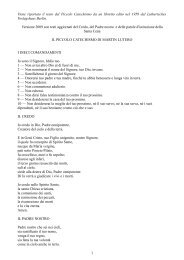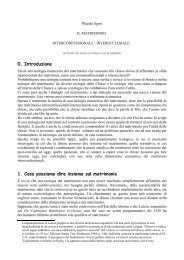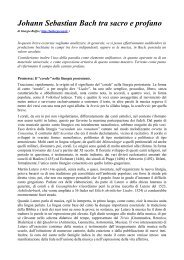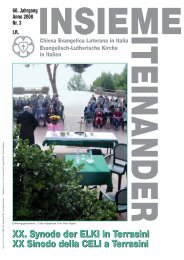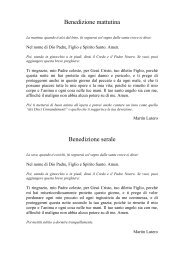Il dialogo ecumenico e interreligioso: quale futuro? - Nemesistemi
Il dialogo ecumenico e interreligioso: quale futuro? - Nemesistemi
Il dialogo ecumenico e interreligioso: quale futuro? - Nemesistemi
You also want an ePaper? Increase the reach of your titles
YUMPU automatically turns print PDFs into web optimized ePapers that Google loves.
<strong>dialogo</strong> potrebbe essere questa apertura che ci permette di non considerarci come perno 'a se stante'<br />
della verità. La sorprendente formula di Dostoevskij ce lo ricorda: "è la verità soltanto, perciò è<br />
ingiusto" 1 . <strong>Il</strong> fenomeno dell'atteggiamento dialogico nasce, comunque, dalla presa di coscienza di<br />
una immancabile ristrettezza o imperfezione della conoscenza umana in questa vita 2 . Nell ambito<br />
<strong>ecumenico</strong>, ciò permetterebbe soprattutto di superare i malintesi e valutare pienamente la<br />
differenza 3 .<br />
CI SI CONOSCE O CI SI VUOL CONOSCERE NELL INDISPENSABILE RECIPROCITÀ<br />
DALL ASCOLTO MUTUO<br />
Si è preso coscienza che solo "in questo <strong>dialogo</strong> si potrà acquistare una conoscenza più vera<br />
ed una valutazione più equa della dottrina e della vita dell'una e dell'altra comunione" 4 . "...verrà<br />
espressa con più adeguatezza la nostra fede" 5 . Lo scambio comunicativo a perciò- un fine:<br />
"scoprire" la verità 6 . Ed è qui che appare tutta l'ambivalenza umana del <strong>dialogo</strong>:<br />
<strong>dialogo</strong>-capirsi-troppo-bene e <strong>dialogo</strong>-intuire-oltre. <strong>Il</strong> <strong>dialogo</strong> implica l'interrogare e lasciarsi<br />
interrogare, consegnarsi nelle mani dell'altro 7 . <strong>Il</strong> <strong>dialogo</strong> diventa possibile là dove ambedue le parti<br />
1<br />
.<br />
/ F. Dostoevskij, / L'idiota, 1970, I / Torino 1984, . 140-141 (V. II) / pp. 510-511. <strong>Il</strong> principe My kin<br />
rappresenta la figura simbolicamente cristica del romanzo. Le sue osservazioni rispecchiano spesso quel riferimento più profondo. Nelle sue<br />
conversazioni con Aglaja, ragazza emblematica. Egli ricorda un giudizio fatto sul ragazzo particolarmente travagliato e contradittorio, Ippolít, ed<br />
osserva: «Poco fa avete detto ad un tratto una parola assennatissima. A proposito della mia opinione su Ippolít, avete detto Non è che la verità, e<br />
perciò è ingiusto . Me ne ricorderò e ci penserò su» (cfr A. Joos, <strong>Il</strong> Cristo di Dostoevskij e l'esperienza cristiana russa, in «Rassegna di teologia», nº<br />
6, pp. 539-557).<br />
2<br />
P. Rossano, Missione e <strong>dialogo</strong>, in «Oikumenikon», 1973 nº 10, p. 233: «L'attitudine al <strong>dialogo</strong> fu finalmente stimolata dall'esperienza, oggi più<br />
profondamente avvertita, del carattere sempre relativo e imperfetto della conoscenza umana; nonché dei limiti che, storicamente parlando, restringono<br />
la conquista della verità. Se la verità logica consiste in una relazione di adesione e di fedeltà all'essere, bisogna tuttavia aggiungere che l'essere stesso<br />
non è mai raggiunto dalla persona umana storica in modo esauriente e totale. Rimangono sempre, inevitabilmente, zone d'ombra e di mistero. Oggi gli<br />
uomini hanno preso di questo fatto inequivocabile una nuova e più acuta coscienza».<br />
3<br />
D. T. Irvin, Towards a hermeneutics of difference at the crossroads of ecumenics, in «The Ecumenical Review», Oct, 1995: «In line with this call to<br />
the churches, I would like to explore a more adequate "ecumenical hermeneutics of difference" that would enable churches to understand the diversity<br />
encountered in their dialogue at the crossroads. Through the lens of this hermeneutic of difference we can examine specific concerns which embrace<br />
both' unity and diversity. Along these lines I will briefly examine the conciliar theme which has occupied much of the recent conversation. Openness<br />
to the "permanent newness of meaning" is ultimately grounded in that permanent openness to one another and to God, which is a task of the<br />
ecumenical movement precisely because it is a mark of divine koinonia. Towards a hermeneutic of difference. First, then, the step towards a<br />
hermeneutic of difference. No church can today escape the multiplicity of traditions that characterizes the Christian way.(2) Christian communities in<br />
the modern and post-modern worlds find themselves living with increasing diversity in expressions of faith, in ever-closer proximity to one another. It<br />
is not uncommon today to discover "evangelical" and "catholic" convictions coexisting side by side within the same Christian congregation. Often a<br />
single community embraces within its own membership those who find their faith nurtured by charismatic, revivalistic and eucharistic forms of<br />
expression. New, complex fusions of multiple cultural and ecclesial forces in more or less stable syntheses are no longer the exception but the rule, at<br />
both the local level and at the trans-congregational levels of ecclesial life. Churches in the ecumenical movement today would do well to attend to the<br />
multiple forces and expressions that trace across their religious fields and make themselves manifest in their various places of worship. They might<br />
find that what they take to be centres of ecclesial life are already crossroads. And they might discover that ecumenical theology can assist them not so<br />
much with constructing a new centre as with mapping the crossroads. In these endeavours, however, churches are hampered by the lack of an<br />
adequate ecumenical hermeneutics. Most of the hermeneutical models employed in the ecumenical movement this century have been adapted from<br />
Western philosophical systems that have extolled uniformity or singularity of meaning. The hermeneutical methods that have been employed by<br />
ecumenical theology have for the most part been characterized by the "metaphysics of presence" that mark the Western onto-philosophical project.(3)<br />
This philosophical tradition, according to its critics, "consists in suppressing or reducing all forms of otherness by transmitting their alterity into the<br />
Same".(4) Too often in its pursuit of consensus or convergence the ecumenical movement has failed to appreciate the "alterity" of Christian traditions.<br />
By the same token, continuing differences among various branches of the movement are perceived to be signs of its failure rather than expressions of<br />
its success. Not surprisingly these same ecumenical hermeneutical models have been rather closely tied to the dominant ecclesial interests of the<br />
North Atlantic churches and have had more than a whiff of imperialism about them. A more adequate hermeneutics might allow us to recognize the<br />
increasing diversity of Christian traditions, including their conflicts and tensions. as a mark of the openness that is characteristic of God's new event.<br />
In the dialogue of our differences, even when manifested as disagreements or through refusals to join together in a common witness, the ecumenical<br />
movement might well be accomplishing its task».<br />
4<br />
CONCILIO ECUMENICO VATICANO II, Decreto "Unitatis Redintegratio", Città del Vaticano 1965, nº 4: «Infatti per mezzo di questo <strong>dialogo</strong><br />
tutti acquistano una cognizione più vera e una più equa estimazione della dottrina e della vita di entrambe le Comunioni, e inoltre quelle Comunioni<br />
conseguono una più ampia collaborazione in qualsiasi dovere richiesto da ogni coscienza cristiana per il bene comune e, se talora si può, convengono<br />
a pregare insieme. Infine, tutti esaminano la loro fedeltà alla volontà di Cristo circa la Chiesa e, com'è dovere, intraprendono con vigore l opera di<br />
rinnovamento e di riforma».<br />
5<br />
CONCILIO ECUMENICO VATICANO II, Decreto "Unitatis redintegratio", Città del Vaticano 1965, nº 9.<br />
6<br />
JOINT WORKING GROUP OF THE WORLD COUNCIL OF CHURCHES AND THE ROMAN CATHOLIC CHURCH, On the ecumenical<br />
Dialogue, in «The ecumenical Review», 1964 nº 4, p. 470: «I.- -Nature of the dialogue Etymologically dialogue means a conversation; but a<br />
conversation with an aim: to discover the 'thruth . All dialogue involves anexchange, an interplay between speakking and suggesting on the one hand<br />
and listening and receiving on the other. Dialogue is, therefore,he opposite of monologue. It requires reciprocity and a certain equality, which does<br />
not prejudice each participant s personal convinction or opinion that his communion is more authentic or closer to the truth. Dialogue supposes that<br />
the interlocutor is not necessarily to adhere to the other's convictions, that he also has something to give, questions to answer and to raise, so that<br />
through the reciprocity of give and take we can go forward towards realising God's will for His people».<br />
7<br />
W. Becker, Bemerkungen zur Vorgeschichte und Eigenart der Arbeitsdokument über den ökumenischen Dialog, pro manuscripto, Roma 1970, S. 42.<br />
24



